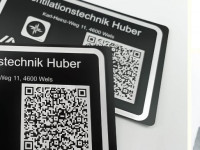Laser classes and safety
What to consider when using laser engravers and laser cutters
Laser engravers and laser cutters are powerful tools used in many fields, from industry to art. They work with laser beams that can cut or engrave materials such as wood, plastics, acrylic, leather and even metal. An important safety measure when using laser engravers and laser cutters is understanding the different classes of lasers and their hazard levels.
There are four main classes of lasers used in laser engravers and laser cutters: Class 1, Class 2, Class 3 and Class 4.
Laser Class 1
These lasers are the safest and have no known hazards. They are either fully protected (shrouded) or produce such low laser powers that they pose no hazard to the eyes or skin.
Laser Class 2
These lasers are also classified as safe when used properly. They produce low power laser beams and as long as the interaction time with the eye is less than 0.25 seconds (eyelid closure reflex), these devices are considered safe.
Laser class 3
Such devices are moderately dangerous and should only be used by people who are aware of the risks involved. They produce laser beams of moderate to high power and can damage the eyes and skin if aimed directly at them. They are commonly used in laser printers, scanners and medical equipment.
Laser Class 4
Lasers so classified are the most dangerous and should only be used by qualified professionals. They produce high-powered laser beams that are capable of cutting and engraving materials. They can also damage the eyes and skin if the laser beam strikes directly or even indirectly by means of reflections. Such devices are commonly used in industrial applications such as laser cutters, laser engravers and laser welders.
Each material processing laser (the source itself) is classified as a laser class 4. Only when installed in a fully enclosed system monitored by interlocks does the overall system become laser class 1 or 2!
How can laser safety be increased?
It is important to be aware of the hazards associated with the use of laser engravers and laser cutters and the safety measures that come with these devices
There are some steps that can be taken to further enhance laser safety with laser engravers and laser cutters, minimize hazards, and protect yourself and others from injury:
- Always use protective equipment, such as safety glasses appropriate for the laser being used, to protect your eyes from the laser beam.
- Make sure the laser engraver or laser cutter is located in a well-ventilated area or connected to a properly sized exhaust system to remove fumes and gases generated during engraving or cutting.
- Always use the laser engraver or laser cutter according to the manufacturer's instructions and follow the recommended safety precautions.
- Make sure that all safety devices on the laser engraver or laser cutter are functioning properly and that all laser beam warning indicators are turned on.
- Always plug the laser engraver or laser cutter into a properly grounded electrical outlet.
- Do not use the laser engraver or laser cutter when you are tired or distracted and always operate the machine under supervision!
- Have the laser engraver or laser cutter serviced by qualified technicians and maintain it in accordance with the manufacturer's instructions.
Laser classes for JustLaser laser engravers and laser cutters
JustLaser's laser cutters combine legally mandated safety standards with best-in-class practicality. In addition, JustLaser is the only company on the market that officially offers CE-certified laser class 2 for laser machines in the class of large-area open laser cutters - this in normal operation and in compliance with the intended use. The latter states in particular that no metals may be processed, as these lead to strong reflections. Organic workpieces, on the other hand, can be processed in compliance with laser class 2.
The JustLaser laser cutters are designed in such a way that Class 4 areas are protected by covers or special devices. Covers that can only be removed by means of tools are clearly marked by warning stickers.
This effectively protects laser operators from all beam components of the processing laser, as well as from reflected or scattered radiation from the processing laser. This can be done without enclosure, i.e. simple loading is possible.
In normal operation (i.e., not in service operation, which can only be performed by JustLaser service personnel anyway) and when used as intended, laser class 2 can thus be maintained, which means that operators can always work safely. However, indirect hazards (e.g. fire hazard) and a possible hazard from the pilot laser (<1mW, 650nm) are still present.


